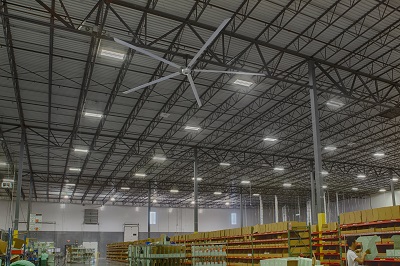Other Voices: A primer on high-velocity, low-speed (HVLS) fans
How the right HVLS solution can radically transform a company's wellness standards while boosting its bottom line.

Editor’s note: The following column by Mark D’Agostino, senior vice president and general manager of Hunter Industrial Fans, is part of Modern’s Other Voices column, a series featuring ideas, opinions and insights from end-users, analysts, systems integrators and OEMs. Click here to learn about submitting a column for consideration.
————-
The quality of the air we breathe is critical, but managing indoor air quality can be quite challenging. While there are many conventional options available—ranging from HVAC units to high-speed floor fans—these traditional options often fail to provide comprehensive solutions. However, high-volume, low-speed (HVLS) fans can mobilize and de-stratify large volumes of air in any facility, enabling HVAC systems to operate more efficiently while also optimizing comfort and health in unconditioned environments.
The term “indoor air quality” refers to the quality of air within and around buildings and structures, particularly relating to the health and comfort of building occupants. Poor air quality––which includes an excess of hot or cold air, indoor pollutants and stagnant air––can cause labored breathing and illness in employees while also posing product quality control risks such as condensation buildup and spoilage.
In fact, the U.S. Department of Labor’s Occupational Safety and Health Administration (OSHA) highlighted these dangers in their heat safety campaign and winter weather advisory––linking cases of cold stress and heat exhaustion in employees to extreme air temperatures and/or humidity levels.
However, it’s been proven that air quality can be improved by simply increasing air circulation. HVLS fans are particularly adept at this, providing large-scale airflow, preventing stagnant air and dust while also helping eliminate toxic airborne chemicals. Additionally, HVLS fans can manage a facility’s moisture, which can form on the walls and equipment on the plant or factory floor between two different climate-controlled environments. Proper indoor air movement can quickly dry this condensation to reduce fall risks, pollutants and bacteria associated with unchecked moisture.
Air quality is one of the leading contributors to workforce comfort because there is nothing quite so pervasive as the air in which employees breathe and work daily. By creating a more comfortable, healthier work environment, HVLS users report reduced absenteeism and employee complaints coupled with boosts in overall productivity.
While some of the key differentiators between an HVLS fan versus traditional high-speed fan options include reduced noise and minimized energy consumption per square foot. The most significant difference is enhanced coverage area and efficiency. HVLS fans have diameters that can range from seven to 24 feet and move large volumes of air with minimized energy consumption per square foot. Just one HVLS fan can replace as many as ten to 20 floor fans or 12 48-inch barrel fans.
In the winter, buildings with high ceilings often experience significant heat stratification where warmer air rises to the ceiling while cooler air remains at floor level. This issue forces a facility’s heaters to work two to three times harder to keep employees and building occupants adequately warm. HVLS fans, however, help circulate the air so that warm air trapped at ceiling level is pushed down to the floor. This also allows HVAC systems to work more efficiently, potentially saving up to 30 percent on heating costs.
HVLS fans are a comprehensive solution to improve workforce health and safety conditions across industries. And that safety has been proven to be linked to the very air that employees breathe. The importance of a facility’s air circulation and air management can’t be underestimated, and investments in the right HVLS solution for your facility can make radical transformations in a company’s wellness standards while boosting its bottom line.

Article Topics
Blogs News & Resources
Two voices of reason on pallet materials 60 Seconds with Bob Trebilcock, outgoing executive editor, Modern Materials Handling Learn from lift truck service history The reBound Podcast: How Pitney-Bowes is innovating with autonomous vehicles. Packaging Corner: Be open to change 60 Seconds with Robert Martichenko of American Logistics Aid Network The reBound Podcast: Looking for talent in all the right places: How Essendant is revolutionizing recruitment More BlogsLatest in Materials Handling
Beckhoff USA opens new office in Austin, Texas Manhattan Associates selects TeamViewer as partner for warehouse vision picking ASME Foundation wins grant for technical workforce development The (Not So) Secret Weapons: How Key Cabinets and Asset Management Lockers Are Changing Supply Chain Operations MODEX C-Suite Interview with Harold Vanasse: The perfect blend of automation and sustainability Consultant and industry leader John M. Hill passes on at age 86 Registration open for Pack Expo International 2024 More Materials HandlingSubscribe to Materials Handling Magazine

Find out what the world's most innovative companies are doing to improve productivity in their plants and distribution centers.
Start your FREE subscription today.
April 2024 Modern Materials Handling

Latest Resources










